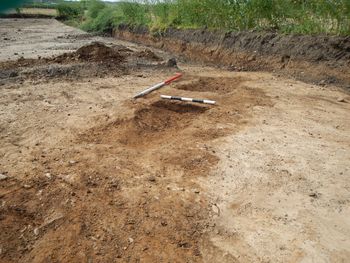Land at Dalton Heights, Seaham, Durham. Excavation (OASIS ID: adarchae1-386053)
AD Archaeology Limited, 2020. https://doi.org/10.5284/1079012. How to cite using this DOI
Data copyright © AD Archaeology Limited unless otherwise stated
This work is licensed under a Creative Commons Attribution 4.0 International License.
Primary contact
AD Archaeology Limited
South Shields Business Works
Henry Robson Way
South Shields
NE33 1RF
Resource identifiers
- ADS Collection: 3751
- DOI:https://doi.org/10.5284/1079012
- How to cite using this DOI
Introduction

AD Archaeology was commissioned by Bellway Homes to undertake an archaeological strip, map and record excavation on land at Dalton Heights, Seaham, Durham, prior to the construction of a housing development. The excavation followed on from a desk-based assessment (NAA 2015), geophysical survey (GSB 2014) and evaluation trenching (AD Archaeology 2019).
The excavation revealed a complex sequence of features representing the eastern end of a settlement that originally would have extended west and south-west of the development area. It seems most likely that much of the settlement has been destroyed during the construction of the A19 road. A complex sequence of gullies, postholes, fence-lines and cut features were located. Whilst it is clear that these features form part of a settlement its layout is unclear in part because of the fragmentary nature of the surviving remains. Additionally the features were located at the eastern end of a settlement, perhaps in an area where one could anticipate a lower degree of formal planning.
Dating evidence in the form of 20 sherds of Roman pottery was recovered, with no earlier or later artefactual evidence. The only fabrics represented were Crambeck reduced ware (CRA RE) and calcite-gritted ware (HUN CG), and all the sherds date to after c.260 AD. Four radiocarbon samples produced dates belonging to the late Roman period with a date range of 254-412 calAD. However, it is clear that there is a background of prehistoric activity at the site with one radiocarbon sample producing a Neolithic date (3658 calBC) and two of late Iron Age date (275-176 calBC). Thus although the dating evidence confirms the presence of late Roman rural settlement at the site, rather than being a settlement de novo it seems likely rather, that it developed on a site with late Iron Age and possibly earlier prehistoric antecedents. It is unclear when the late Roman rural settlement came to an end, but no dating evidence or material culture was recovered that indicated a continuity into the post Roman period.
It is clear that the majority of features uncovered belong to a rural Roman Britain settlement of some complexity, whose material culture, does not conform to typical late Iron Age native settlement patterns. Prior to the advances in archaeological techniques and methodologies in the last 15 years relatively few Roman rural settlements had been identified in Durham. The importance of the location of the Dalton Heights site is that it forms one of a sequence of discoveries that is significantly revising the understanding of the Roman period in the area south of Hadrian’s Wall. There is little doubt further similar sites await discovery in this area and the apparent scarcity of late Roman rural sites relates more to the difficulty in locating and recognising such sites rather than a function of their scarcity.





